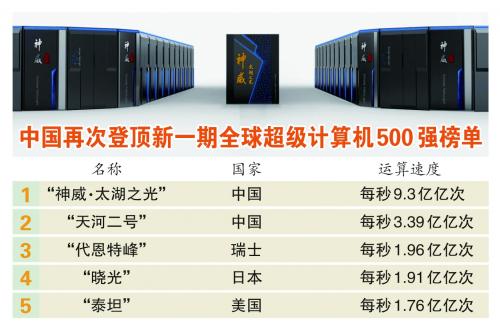
Reporter Liu Yang, Special Correspondent
China has officially taken the lead in the global supercomputing race, surpassing the United States for the first time in the number of supercomputers listed on the TOP500. According to a report by the BBC on the 14th, the latest edition of the global supercomputer ranking showed that China's "Shenwei Taihu Lake" and "Tianhe II" have once again claimed the top two spots for the fourth consecutive time. With 202 high-performance computers in the list, China now holds the largest number globally, compared to the U.S., which has only 143. This marks the lowest number the U.S. has ever had since the TOP500 list began 25 years ago, though it still maintains second place. Many international media outlets have highlighted this shift, suggesting that the "Chinese supercomputer era" is here. But what does this mean for the future of Sino-U.S. competition in high-performance computing? To explore this, Global Times reporter spoke with Zhang Yunquan, an expert in China’s supercomputing industry.
China Dominates the Top Five
The top five supercomputers in the new list are from four different countries. China's "Shenwei Taihu Lake" tops the list with a speed of 9.3 petaflops per second (93P), followed by China's "Tianhe II" and Switzerland's "Piz Daint." The U.S. "Titan," which previously held the fourth position, was overtaken by Japan's "Fugaku" and now ranks fifth. In addition to leading in the number of systems, China also leads in total computational power, accounting for 35.4% of the world's total, compared to the U.S.'s 29.6%. Japan follows with 35 systems, while Germany ranks fourth with 20.
Zhang Yunquan, secretary-general of the High Performance Computing Committee at the China Computer Society and director of the National Supercomputing Jinan Center, told the Global Times that the continued dominance of Chinese systems is expected. He believes that China may reclaim the top spot in the next year.
However, upon reviewing the data, it was noted that "Tianhe II" retained its second position without any change in performance, suggesting that its planned upgrade may not yet be complete. Previously, it was expected to reach around 90P.
Is the Chinese Supercomputer Era Here?
According to the Voice of Germany, the era where the U.S. dominated the global supercomputer rankings is now over. China has not only climbed to the top but also surpassed the U.S. in the total number of supercomputers. Four months ago, the U.S. led China in the count with 169 systems. This shift highlights China’s growing investment in R&D, which now accounts for 20% of the world’s total. Eric Stromile, co-founder of the TOP500 list, told the BBC that many Chinese systems are being developed for commercial use, offering their processing power to companies both locally and internationally.
He added that other countries’ interest in supercomputing rankings stems from two factors: first, the U.S. has long been a leader in scientific research, so if another country takes its place, it could affect national reputation. Second, supercomputers are used for scientific exploration and national security, including applications related to weapons systems.
Regarding the decline in U.S. supercomputer numbers, Lewis, a U.S. strategist, told the Voice of Germany that inconsistent science policy in the U.S. has contributed to this. Focus has shifted toward politically sensitive projects, and funding competition among researchers has intensified. Supercomputing reflects this trend, as it plays a role in the arms race between the U.S. and China.
The Voice of Germany also pointed out that for complex calculations, data quality often matters more than sheer quantity. While the TOP500 still measures floating-point operations, many experts argue that this standard is outdated and not always practical.
Zhang Yunquan emphasized that China's growth in supercomputing comes largely from AI applications, driven by the booming domestic tech sector. However, he cautioned that China still lags behind the U.S. in scientific computing. Looking ahead, he predicts a shift in the global supercomputing landscape, with the U.S. potentially regaining the lead in performance in the second half of 2018 or 2019, while China may continue to dominate in quantity.
China's Chance to Lead the Next Generation
Although the U.S. may regain the top spot in performance, China is not standing still. According to Zhang Yunquan, all major supercomputing nations are now working on the next generation—E-class supercomputers capable of reaching 1,000 petaflops. The U.S. is expected to develop one by 2021 or later, while China aims to launch its E-class system in 2020, making it the first globally. With existing 100P systems already deployed, China is well-positioned to take the lead in the E-era.
Zhang also shared updates on China's E-class supercomputer development at three national centers, including the Jinan center. Deployment will begin next year, with one or two centers selected to eventually build the nation's E-class machine. â–²
P01 Series Push Wire Connectors
Push-in wire connector with good clamping force
For solid/stranded/tinned flexible wires
Transparent housing for visual inspection of connection
Interlock housing for orderly installation
Colour-coded for easy identification
BELEKS P01 series push wire connectors,quick connector,push-in connectors,2.5 mm² fast connectors
Jiangmen Krealux Electrical Appliances Co.,Ltd. , https://www.krealux-online.com